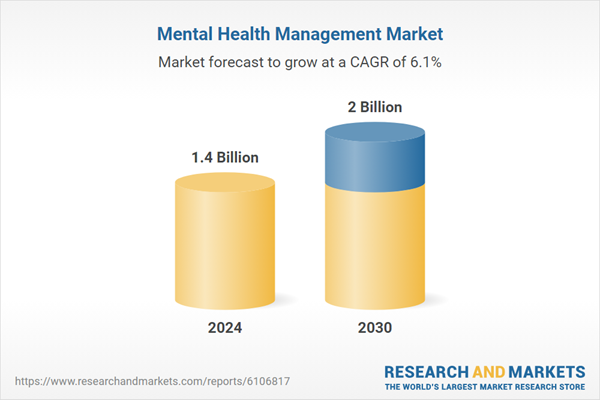Global Mental Health Management Market - Key Trends & Drivers Summarized
Why Is Mental Health Management Gaining Urgency in Today's Global Healthcare Landscape?
Mental health management has become one of the most urgent priorities in global healthcare as the prevalence of psychological disorders continues to rise amid increasingly complex social, economic, and environmental pressures. Conditions such as depression, anxiety, bipolar disorder, and post-traumatic stress are affecting individuals across all age groups and socioeconomic backgrounds, creating both personal and public health challenges. The World Health Organization has identified mental health as a critical component of overall well-being, noting that untreated mental illnesses significantly contribute to global disability and reduce life expectancy. Factors such as social isolation, workplace stress, economic uncertainty, conflict, and the lingering effects of the COVID-19 pandemic have amplified psychological distress in many populations. In response, there is a growing recognition that mental health must be treated with the same seriousness as physical health, integrated into primary care services, and supported by policies, education, and infrastructure. Efforts are now being made to reduce stigma, improve access to care, and encourage early intervention strategies. Governments, employers, educators, and healthcare systems are collaborating to create environments that promote psychological resilience and provide appropriate therapeutic pathways. Mental health management is no longer confined to psychiatric institutions but has expanded to community clinics, schools, digital platforms, and workplace programs, signaling a shift toward inclusive, proactive care that recognizes the profound connection between emotional well-being and quality of life.How Are Technology and Digital Health Tools Transforming Mental Health Management?
Technology is playing a transformative role in mental health management by expanding access, personalizing care, and enabling continuous support outside traditional clinical settings. Digital health tools such as mobile apps, teletherapy platforms, AI-powered chatbots, and virtual reality are increasingly being used to monitor, diagnose, and treat mental health conditions in real time. These technologies are especially impactful in regions with limited access to trained mental health professionals or where stigma discourages in-person therapy. Mobile applications now offer features like mood tracking, guided meditation, journaling, cognitive behavioral exercises, and peer support communities, giving users more autonomy in managing their mental well-being. Telehealth services have also surged in popularity, offering secure and convenient connections to licensed therapists and psychiatrists from the comfort of one's home. Artificial intelligence is being leveraged to detect early signs of emotional distress through speech patterns, writing analysis, and behavioral data, allowing for preventive interventions before crises occur. Virtual reality therapy is being used to treat phobias, PTSD, and anxiety disorders by simulating controlled, therapeutic environments. Additionally, wearable devices can monitor physiological indicators like heart rate variability and sleep quality, offering insights into stress and emotional regulation. These technological advancements are not only improving patient outcomes but also reshaping the mental health landscape into one that is more dynamic, responsive, and inclusive of diverse needs and lifestyles.How Do Societal Attitudes, Cultural Contexts, and Economic Factors Influence Mental Health Management?
Societal attitudes, cultural beliefs, and economic conditions play a critical role in shaping how mental health is perceived, addressed, and managed across different populations. In some regions, longstanding stigma and misinformation around mental illness lead individuals to suffer in silence or rely on informal or spiritual healing methods rather than seek professional care. Cultural norms often dictate whether emotional expression is encouraged or suppressed, which influences help-seeking behavior and the types of treatment that are deemed acceptable. In high-income countries, mental health awareness campaigns, insurance coverage, and educational resources have created environments where therapy and medication are increasingly normalized. However, in low- and middle-income countries, access to mental health services remains extremely limited due to underfunded health systems, workforce shortages, and lack of integration within primary care. Economic factors also influence treatment adherence, with the cost of therapy, medication, and transportation acting as major barriers for many individuals. Employment conditions, such as job insecurity or toxic work cultures, can exacerbate stress and emotional strain, while the absence of mental health provisions in workplace benefits adds to the challenge. Furthermore, marginalized groups often face intersecting forms of discrimination, trauma, and systemic inequities that elevate mental health risks but reduce access to care. Addressing these complex dynamics requires a culturally sensitive, community-based approach that empowers individuals and ensures that mental health management is equitable, sustainable, and grounded in local realities.What Are the Main Drivers Accelerating the Global Mental Health Management Market?
The growth in the mental health management market is driven by several powerful and interconnected trends that span public health policy, consumer behavior, technological progress, and demographic change. First, the global increase in mental health awareness and reduced stigma is encouraging more individuals to seek help, thereby expanding the demand for accessible and effective treatment options. Second, the rise in stress-related conditions linked to urbanization, digital overload, economic pressure, and lifestyle imbalances is creating an urgent need for scalable solutions. Third, the integration of mental health into primary healthcare systems is becoming a strategic priority for governments, supported by global health organizations and funding initiatives. Fourth, technological innovation is enabling new forms of care delivery, including app-based therapy, remote diagnostics, and AI-enhanced support systems, which cater to both underserved populations and digitally native users. Fifth, workplace wellness programs and corporate mental health initiatives are gaining momentum as employers recognize the impact of psychological well-being on productivity, retention, and organizational culture. Sixth, research into neurobiology, psychopharmacology, and behavioral science is contributing to more precise and personalized treatment approaches. Seventh, the expanding role of insurance coverage for mental health services, especially in developed countries, is lowering financial barriers and boosting market participation. Lastly, increased collaboration between public health bodies, NGOs, tech companies, and educational institutions is fostering innovation and broadening the reach of mental health management strategies. These drivers collectively reflect a paradigm shift in how mental well-being is prioritized, treated, and integrated into broader visions of public health and societal advancement.Report Scope
The report analyzes the Mental Health Management market, presented in terms of market value (US$). The analysis covers the key segments and geographic regions outlined below:- Segments: Product (Mental Health Device, Mental Health Platform); Therapy (Cognitive Behavior Therapy, Electrotherapy, Other Therapies); Application (Stress Application, Anxiety Application, Depression Application, Bipolar Disorder Application, Schizophrenia Application, Other Applications).
- Geographic Regions/Countries: World; United States; Canada; Japan; China; Europe (France; Germany; Italy; United Kingdom; Spain; Russia; and Rest of Europe); Asia-Pacific (Australia; India; South Korea; and Rest of Asia-Pacific); Latin America (Argentina; Brazil; Mexico; and Rest of Latin America); Middle East (Iran; Israel; Saudi Arabia; United Arab Emirates; and Rest of Middle East); and Africa.
Key Insights:
- Market Growth: Understand the significant growth trajectory of the Mental Health Device segment, which is expected to reach US$1.4 Billion by 2030 with a CAGR of a 7%. The Mental Health Platform segment is also set to grow at 3.9% CAGR over the analysis period.
- Regional Analysis: Gain insights into the U.S. market, valued at $376.2 Million in 2024, and China, forecasted to grow at an impressive 9.8% CAGR to reach $407 Million by 2030. Discover growth trends in other key regions, including Japan, Canada, Germany, and the Asia-Pacific.
Why You Should Buy This Report:
- Detailed Market Analysis: Access a thorough analysis of the Global Mental Health Management Market, covering all major geographic regions and market segments.
- Competitive Insights: Get an overview of the competitive landscape, including the market presence of major players across different geographies.
- Future Trends and Drivers: Understand the key trends and drivers shaping the future of the Global Mental Health Management Market.
- Actionable Insights: Benefit from actionable insights that can help you identify new revenue opportunities and make strategic business decisions.
Key Questions Answered:
- How is the Global Mental Health Management Market expected to evolve by 2030?
- What are the main drivers and restraints affecting the market?
- Which market segments will grow the most over the forecast period?
- How will market shares for different regions and segments change by 2030?
- Who are the leading players in the market, and what are their prospects?
Report Features:
- Comprehensive Market Data: Independent analysis of annual sales and market forecasts in US$ Million from 2024 to 2030.
- In-Depth Regional Analysis: Detailed insights into key markets, including the U.S., China, Japan, Canada, Europe, Asia-Pacific, Latin America, Middle East, and Africa.
- Company Profiles: Coverage of players such as AiraWear (by Tware), Beurer GmbH, BioElectronics Corporation, Bloomlife Inc., Cora and more.
- Complimentary Updates: Receive free report updates for one year to keep you informed of the latest market developments.
Some of the 36 companies featured in this Mental Health Management market report include:
- AbleTo Inc.
- Amwell (American Well Corp.)
- BetterHelp (by Teladoc Health)
- Big Health (Sleepio, Daylight)
- Cerebral Inc.
- Compass Pathways plc
- CVS Health (including Aetna Behavioral Health)
- Elemy
- Ginger (now Headspace Health)
- Happify Health
- Ieso Digital Health
- Lyra Health
- MindBeacon (by CloudMD)
- Modern Health
- Quartet Health
- SilverCloud Health (by Amwell)
- Spring Health
- Talkspace Inc.
- Thrive Global
- Woebot Health
This edition integrates the latest global trade and economic shifts into comprehensive market analysis. Key updates include:
- Tariff and Trade Impact: Insights into global tariff negotiations across 180+ countries, with analysis of supply chain turbulence, sourcing disruptions, and geographic realignment. Special focus on 2025 as a pivotal year for trade tensions, including updated perspectives on the Trump-era tariffs.
- Adjusted Forecasts and Analytics: Revised global and regional market forecasts through 2030, incorporating tariff effects, economic uncertainty, and structural changes in globalization. Includes historical analysis from 2015 to 2023.
- Strategic Market Dynamics: Evaluation of revised market prospects, regional outlooks, and key economic indicators such as population and urbanization trends.
- Innovation & Technology Trends: Latest developments in product and process innovation, emerging technologies, and key industry drivers shaping the competitive landscape.
- Competitive Intelligence: Updated global market share estimates for 2025, competitive positioning of major players (Strong/Active/Niche/Trivial), and refined focus on leading global brands and core players.
- Expert Insight & Commentary: Strategic analysis from economists, trade experts, and domain specialists to contextualize market shifts and identify emerging opportunities.
Table of Contents
Companies Mentioned (Partial List)
A selection of companies mentioned in this report includes, but is not limited to:
- AbleTo Inc.
- Amwell (American Well Corp.)
- BetterHelp (by Teladoc Health)
- Big Health (Sleepio, Daylight)
- Cerebral Inc.
- Compass Pathways plc
- CVS Health (including Aetna Behavioral Health)
- Elemy
- Ginger (now Headspace Health)
- Happify Health
- Ieso Digital Health
- Lyra Health
- MindBeacon (by CloudMD)
- Modern Health
- Quartet Health
- SilverCloud Health (by Amwell)
- Spring Health
- Talkspace Inc.
- Thrive Global
- Woebot Health
Table Information
| Report Attribute | Details |
|---|---|
| No. of Pages | 375 |
| Published | December 2025 |
| Forecast Period | 2024 - 2030 |
| Estimated Market Value ( USD | $ 1.4 Billion |
| Forecasted Market Value ( USD | $ 2 Billion |
| Compound Annual Growth Rate | 6.1% |
| Regions Covered | Global |









